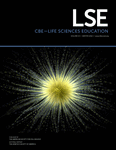Helping Teachers in the Evolution-Teaching Dilemma: Understanding Evolution by Kostas Kampourakis
As a molecular biologist who teaches biology courses for both undergraduates and practicing teachers, I have complicated emotions about teaching evolution. I believe the ideas represented in evolutionary biology are some of the most fundamental in all of biology, and I am amazed at the beauty and explanatory power of these ideas. And yet … with every new group of students, at any level, I feel a responsibility to acknowledge that evolutionary biology comes with a certain amount of social baggage. This is true for any learner but especially for elementary and secondary teachers, who face variable levels of support in their schools and communities when they tackle the topic. Unfortunately, teachers’ grasp of facts and evidence in evolutionary biology may not make a difference in the face of community backlash or an unsupportive administration.

Because of these complicated emotions, I am always on the lookout for resources that will help me to connect evolutionary biology with learners. I evaluated the paperback version of Kostas Kampourakis’s text Understanding Evolution with the goal of determining whether I could use it as a resource for my evolutionary biology course for teachers. The text is intended for undergraduate students or graduates in the life sciences. What grabbed my attention was the author’s background: he actually taught secondary biology for a dozen years and published research on student preconceptions around evolution. It is difficult to imagine anyone with a better background to balance the history of this field and select compelling examples and evidence that show evolution at work. The book provides a valuable resource to help teachers understand the reasons that evolution can be so difficult for students to understand, an area in which many teachers (myself included) struggle.
There are several parts of this book that diverge greatly from a traditional evolutionary biology textbook, and these are the sections I believe would be of most interest to teachers or teacher-educators. In chapter 1, Kampourakis presents a variety of questions that evolutionary biology can answer, including domestication (focusing on research on dogs) and infectious disease (focusing on HIV/AIDS). In the conclusion, he provides a bookend section on questions that evolutionary biology cannot answer, which rather naturally focuses on ethics and religion. These sections are very useful for readers who are grappling with how to set an appropriate tone in discussing evolution in a social or teaching context and therefore would be very useful for a teacher audience.
Kampourakis’s innovative approach extends into the chapters of the text. Chapter 2 is entitled “Religious Resistance to Accepting Evolution,” and chapter 3 is “Conceptual Obstacles to Understanding Evolution.” Both sections are presented in a historical context and contain extensive links to literature relevant to these topics. These sections provide a valuable context for understanding the current controversies that swirl around evolutionary biology. In a practical sense the “conceptual obstacles” chapter allows readers to recognize patterns of thinking that are common to many people and that provide the filters that can lead to misconceptions about evolution. Reading this section gave me ideas about how I might organize a discussion among teachers about how to diagnose and then address these patterns head-on, and I can envision these sections prompting college biology instructors to think similarly about diagnosing their students’ conceptual patterns and then targeting instruction to address those.
In chapters 4 through 6, the focus of the book turns to the actual topic of evolution, and the approach becomes more traditional. There is an extensive chapter on Charles Darwin, the venerable grandfather of evolutionary biology, and a review of his travels and insights into natural history that led to his publication of On the Origin of Species. Just two chapters follow, one on common ancestry and one on evolutionary change processes. Each section provides a thorough overview of important principles, along with helpful diagrams and tables (although the figures were reproduced in black and white in my paperback copy, which did not work well for all the figures). As with the earlier chapters, the content chapters were extensively referenced and situated in the important research literature appropriate for each topic. I found both of these chapters to be very densely packed and, because my biology specialty is not in evolutionary biology, quite terminology intensive. To be fair, the terms are generally defined and there is a glossary. I came away thinking that, for a review of evolutionary principles in an undergraduate course or one for teachers, I would rely on textbook-style resources written in a more conversational style. However, I can see the utility of these sections as a review for graduates who are working in the field of evolutionary biology.
A feature of this book that would be useful for any reader is the further reading suggestions at the end of each chapter. In these sections, Kampourakis recommends essays and books that contextualize the information presented in the chapters. He provides a bit of commentary as to the strengths and challenges in each. I found myself wanting to use these sections to create reading lists for my own continued learning and for teachers who are interested in exploring these ideas in more depth.
Overall, I will use Understanding Evolution as a resource in my courses for schoolteachers. The book’s unique focus brings together several important threads that teachers must consider in their own decision making about teaching evolution and provides some useful references and suggestions about the big ideas underlying evolutionary biology. The focus on common barriers to understanding evolution is useful for anyone who is teaching the topic in a formal or informal context. As a resource for individuals who are already well grounded in evolutionary biology, I think the central chapters could provide a valuable digest for concepts and connections, but I would not use these chapters to teach learners who are coming to the field as novices or those who are unfamiliar with the extensive terminology in this domain of biology.



